Dr.
Freeman's Talk on:
Moving Forward with Cyberinfrastructure: Some Straight Talk
Slide Presentation:

Good morning.
I'm not sure that NSF's intentions concerning the future
of the PACIs and the transition to cyberinfrastructure came across clearly
in my All Hands Meeting keynote in San Diego, so I am glad that I have
this opportunity today to clarify things. As the title indicates, I will
try to be very clear.

Let me begin by congratulating you on a series of remarkable
achievements

NCSA has just held a richly-deserved celebration.
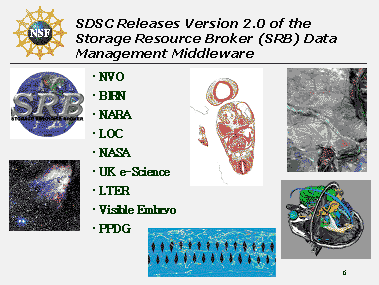
The work of the PACI-EOT activity serves as a model and
we are actively working toward cloning and extending that activity.
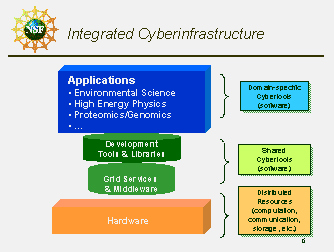
The work that NCSA - and most especially Dan Reed - have
done on the NEESgrid illustrates the high level of competence and integrity
that has been built up here.
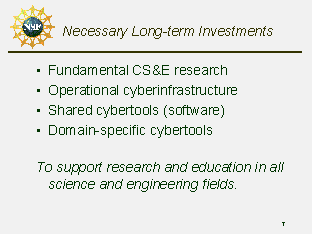
Together you all have done a remarkable job of providing
computational power to the S&E community over the years at a rate
that has tracked very closely the Moore's Law curve.
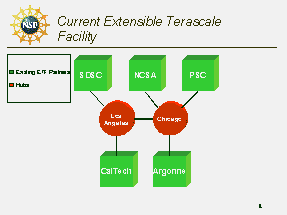

And the vision spelled out in the Atkins Report - to which
many of you contributed - could not have even been dreamed of without
the pioneering work that many of you did.
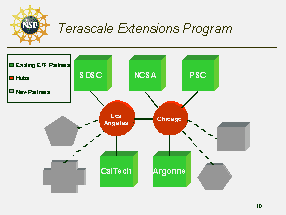
Let me tell you as clearly as I can what we at NSF are thinking
about when we talk about cyberinfrastructure. First, it is important to
understand that cyberinfrastructure will be the integration of essentially
all of the computing resources and services and people that we currently
have operating or under construction. Second, you must keep in mind that
cyberinfrastructure ultimately will not belong just to NSF because others
must also build and operate parts of it. The corollary to this is that
cyberinfrastructure is what is seen by each scientist or engineer - not
what we define it to be. And thus it may be that your cyberinfrastructure
is not the cyberinfrastructure of the gal down the hall - BUT, they must
all interoperate.
Now, just what are the elements in general?

Everyone generally agrees that at the base of any cyberinfrastructure
program is hardware, as shown in the lowest level of this viewgraph. We
intend to support the operations and management of all of the existing
PACI and ETF HW. And we intend to make sure that it has the highest capability
computing engines that the community needs and that NSF can find the funds
for.
- Management certainly includes the essential staff that keeps everything
humming smoothly, but moving up to the level of Shared Cybertools on
this (the integrated cyberinfrastructure) viewgraph, it also includes
the people who produce the tools, libraries, Grid services, middleware,
etcetera - the people who in the past you and we have referred to as
making up the "Enabling Technology" teams.
- I believe that people in all areas and at all levels of NSF understand
that building a successful cyberinfrastructure, like building any other
piece of "major research equipment" requires the people who
will make it function properly and efficiently. YOU, are the people
to do that.
- In our rapidly changing field, the hardware necessary to accomplish
any task evolves, and the needs for hardware change. We intend to support
the necessary technology upgrades to keep the NSF computing community
supplied with what they require to advance their science. Since we expect
that the budget for Cyberinfrastructure will be growing, we will balance
the size of these upgrades with the need for new resources - including
truly high-end computers.
- If you remember the slide about Moore's Law showing how the NSF funded
systems have largely stayed ahead of the curve, I want to assure you
that we have every intention of continuing that trend in the future.
The good news here is that this is not going to be a zero sum game.
- What I have been talking about here are essentially NSF's goals of
supporting tools and people to generate ideas, new knowledge. Some of
the people and tools needed for this may reside at your "Resource
Partners".
While we are strongly encouraging them to respond to the announcement
for Terascale Extensions, there may be tools and/or people at these sites
which are necessary for the development and success of cyberinfrastructure.
If that is so, the proposals to NSF for post-PACI funding in FY05 and
beyond must make that case, and have it withstand review. If it does,
these aspects of the Resource Partners will be supported also.
- What is also shown on this (the ICI) viewgraph are the education,
outreach, and training activities of the PACIs. If you believe that
people are an indispensable part of any cyberinfrastructure as I do
(and the Atkins Report agrees), then education, outreach and training
are a requisite that must be supported. The currently supported EOT
activities within the PACIs have been extremely successful. We will
keep this activity in our future scenario, and are looking for ways
to increase its size and scope.
Let me now turn to some specifics:
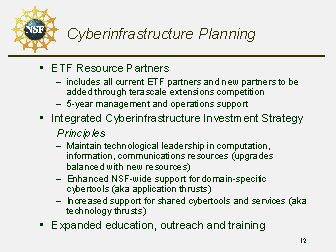
In March we announced a transition plan with the following
elements. The primary reason for doing this is to position you for what
we intend to be significant growth in all aspects of cyberinfrastructure.
Many of you are currently busily building the ETF, which
is the current most-advanced element of cyberinfrastructure.
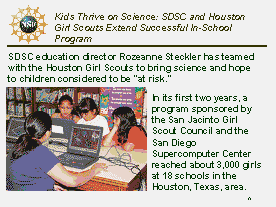
This will result in the next version of ETF:
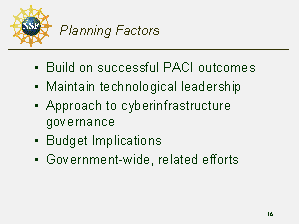
We also made some commitments:
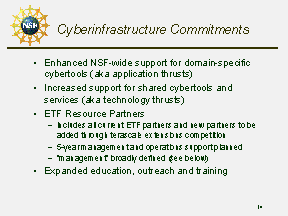
I think we all share the same objective: to build this:
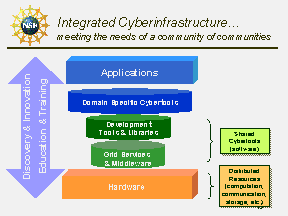
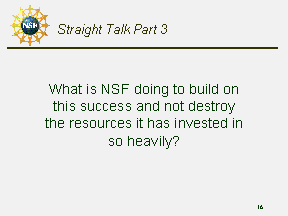
Let me outline some steps we are taking. But, first, we
need to have a quick vocabulary lesson:

Let me outline what we are doing.
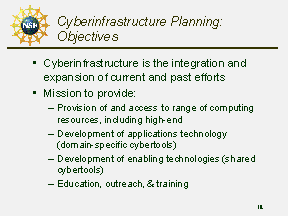
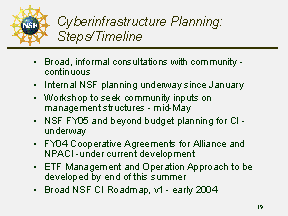
We are embarked on a new venture in almost uncharted territory
here and are soliciting inputs from people who understand management structures;
and, the idea of a workshop to consider management and community structures
was suggested by Fran Berman, and that she and all of the management of
the PACIs are involved, as well as many people from partner sites.
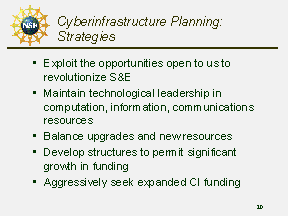

For now, you can work on the investments recommended by
the Atkins Report:
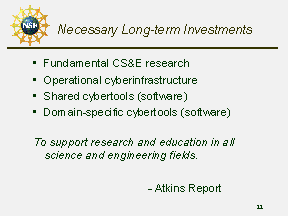
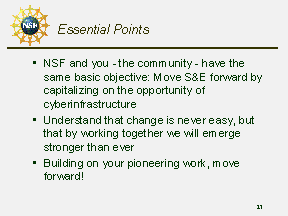
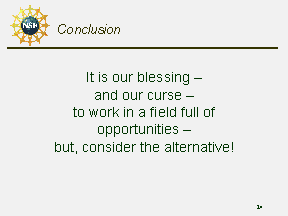
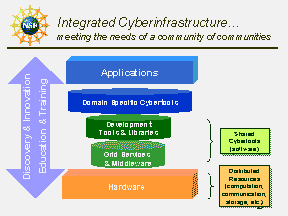
|



